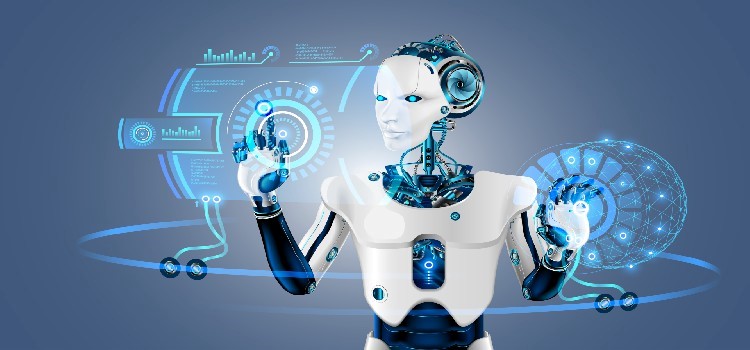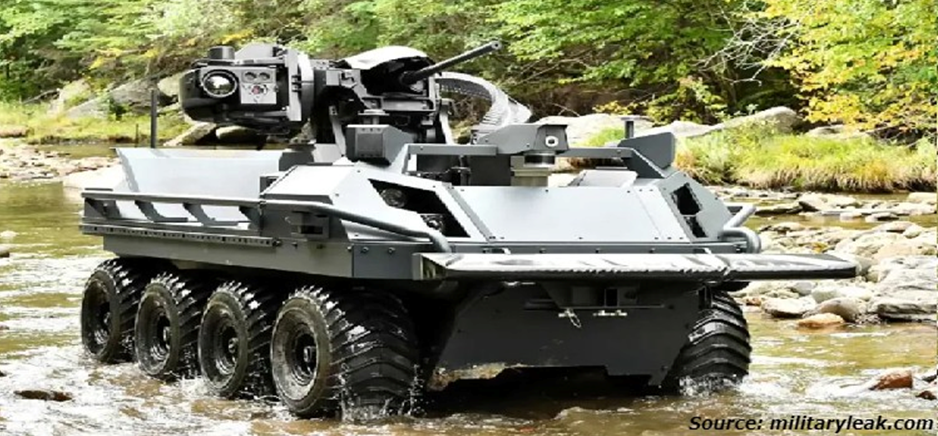
Automotive Robotics by Type (Delta Robots, Collaborative Robots, SCARA Robots, Articulated Robots, and Machine Vision), by Component (Hardware, Software, and Services), and by Application (Material Handling, Assembly & Disassembly, Welding, Painting, Quality Inspection, Pick & Place, and Others) – Global Opportunity Analysis and Industry Forecast, 2024–2030
Industry: Automotive & Transportation | Publish Date: 16-Aug-2023 | No of Pages: 292 | No. of Tables: 221 | No. of Figures: 175 | Format: PDF | Report Code : N/A
Market Overview
The global Automotive Robotics Market size was valued at USD 12.20 billion in 2022, and is projected to reach USD 23.18 billion by 2030, with a CAGR of 8.0% from 2023 to 2030. Automotive robotics refers to the application of robotic systems and technologies in the automotive industry to automate and optimize various processes involved in vehicle manufacturing, assembly, and operation. The primary goal of automotive robotics is to improve efficiency, productivity, and safety in the automotive sector.
Manufacturers can achieve higher precision, accuracy, and consistency in manufacturing processes by implementing robotics. This will lead to better product quality and reduced production time. These robotic systems can perform tasks with speed and repeatability, reducing the likelihood of errors and increasing the overall output.
Increasing Automation in the Automotive Industry
The increasing demand for automation in the automotive industry is driving the rapid growth of the automotive robotics market, as manufacturers seek to enhance efficiency, productivity, and quality in vehicle production. The growth in the implementation of automation enables companies to concentrate on automating operations to cut costs, save time, offer high-quality products, and boost productivity to compete in this industry. Moreover, automotive companies and suppliers such as BMW, Ford Motors Company, and ABB are working with automation technology companies to adopt advanced technologies in their manufacturing plants.
For instance, in April 2021, Ford Motors revolutionized car-making with the first moving assembly line, an innovation that made piecing together new vehicles faster and more efficient than before. Ford also implemented artificial intelligence (AI) in its manufacturing processes to increase efficiency and speed.
Rising Demand for The EVs
The rising adoption of electric vehicles (EVs) with government initiatives is driving the automotive robotics industry growth. For instance, in November 2021, the governments of the U.S., Canada, Mexico, and the U.K. jointly committed to fully converting their fleets of 120,000 vehicles into electric vehicles. This initiative is aimed at achieving zero emissions by 2040, with the objective of reducing greenhouse emissions. Thus, it leads to the high adoption of EVs among consumers.
Moreover, the growing concerns regarding the negative impact of carbon emissions on the environment and climate have surged the demand for electric vehicles worldwide, increasing the demand for robotics in the automotive industry. According to the estimation of the International Energy Agency (IEA), there will be 250 million EVs running on the roads globally to reduce environmental pollution by 2030.
Furthermore, the market is experiencing significant growth due to the increasing efforts by robotics manufacturers to develop robots specifically for the electric vehicle industry. For instance, in January 2022, FANUC launched a new 1,000 kg payload industrial robotic arm named M-1000iA. FANUC's new M-1000iA robot is designed to handle heavy products, including automotive components, construction materials, and battery packs for EVs.
The High Cost of Industrial Robots Restrains the Market Growth
The initial investment for purchasing an industrial robot can be expensive compared to alternatives such as human labor or other human-operated equipment. This can burden smaller operations that may need access to sufficient funds as an upfront investment.
Additionally, industrial robots require routine maintenance and repairs to continue functioning properly, which is quite costly. These maintenance and repair costs can add up over time and may burden smaller organizations that need more resources to cover these extra expenses. Therefore, high initial investment and maintenance costs are anticipated to restrain the growth of the automotive robotics market.
The Emergence of Industry 4.0 Creates an Opportunity for the Industry
The emergence of Industry 4.0 has opened up significant opportunities for the automotive sector. The integration of advanced technologies, such as the Internet of Things (IoT), AI, 5G technology, and big data and analytics, in the automotive industry can revolutionize manufacturing processes and improve operational efficiency. Smart factories with interconnected systems and real-time data allow optimized production, streamlined supply chains, and reduced costs. Industry 4.0 technologies, such as IoT and big data analytics, provide valuable insights into the performance of robotics systems. Data collected from robots and connected devices can be analyzed to identify patterns, optimize operations, and predict maintenance needs. This data-driven approach helps manufacturers make informed decisions, improve process reliability, and minimize downtime.
Additionally, the automotive industry can leverage Industry 4.0 to drive the adoption of electric vehicles and autonomous vehicles. This leads to entry into the growing markets and shaping the future of transportation.
The Asia-Pacific Market Holds the Lion’s Share of the Automotive Robotics Market
Asia-Pacific region holds the largest share, and is expected to continue its dominance during the forecast period. This is attributed to the increased production of automobiles in countries, such as China, India, and Japan. According to the International Trade Administration, China is the world’s largest vehicle market by annual sales and manufacturing output, with domestic production expected to reach 35 million vehicles by 2025. Prominent companies involved in automotive manufacturing have already embraced robotics to streamline their automation processes.
Moreover, the presence of major robotics manufacturers, such as Fanuc Corporation, Kawasaki, Seiko Epson Corporation, and Yaskawa that are adopting product launches as their key developmental strategy, drive the market growth in this region. For instance, in January 2022, FANUC introduced the M-1000iA, a new robot capable of handling heavy products. The robot has a payload capacity of 1,000 kilograms and a reach of 3.25 meters, making it ideal for various applications, including automotive manufacturing, construction, and material handling. This robot is a heavy-duty robot with a wide range of motion. Its serial-link construction makes it more maneuverable than parallel-link robots, and its IP67 dust and water protection makes it ideal for harsh environments.
Europe is Growing Steadily in the Automotive Robotics Market
Europe's well-established automotive sector and heavy investment in EVs and autonomous vehicles are expected to drive the automotive robotics market. According to the European Commission, the turnover generated by the automotive industry represents over 7% of the European Union GDP. In addition, several leading automotive manufacturers, such as Volkswagen, Mercedes Benz, BMW, and Volvo Cars, are investing heavily in Europe, expanding their business, and utilizing automation & robotics to cope with the high demand for electric vehicles.
For instance, in July 2022, Volvo Cars started a new manufacturing plant in Europe to meet the continued demand from its customers for electric cars and tap into the growth potential. These factors are expected to create a high demand for industrial robots in Europe, which drives the growth of the automotive robotics market.
In addition, the governments of various countries in this region are promoting automation in manufacturing. They are also designing advanced robots integrated with AI to boost the industrial sector. For instance, in October 2021, the French President invested USD 929 million package to promote industrial robotics across the country. This, in turn, is further propelling the automotive robotics market growth in Europe.
Competitive Landscape
Various market players operating in the automotive robotics industry include ABB Ltd., Comau S.P.A., Denso Corporation, Fanuc Corporation, Kawasaki Heavy Industries, Ltd., KUKA AG, Nachi-Fujikoshi Corp, Omron Corporation, Seiko Epson Corporation, Yaskawa Electric Corporation, Staubli International, Universal Robots, Mitsubishi Electric Corporation, CMA Robotics S.P.A., and HD Hyundai Robotics. These market players are adopting several strategies, such as product launches and collaborations, across various regions to maintain their dominance in the market.
For instance, in June 2023, ABB launched four new large robot models and 22 variants to support automotive customers to improve productivity, quality, and safety. The new robots are designed to meet the needs of the automotive industry, which is undergoing a major transformation as it shifts to electric vehicles and autonomous driving.
Moreover, in June 2022, Kawasaki Heavy Industries, Ltd. announced a collaboration with Realtime Robotics to automate the programming, deployment, and control of its industrial robots. The combination of Kawasaki’s quality robots, advanced programming platform, and Realtime Robotics software is an industry game changer. It will provide manufacturers from different industries with unprecedented flexibility for various tasks ranging from automating the programming of robotic motion and collision avoidance to the design of the manufacturing floor.
In addition, in April 2022, Yaskawa Electric Company introduced a new technology called i3 (i-cube) Mechatronics based on AI, making robots more intelligent and flexible along with allowing them to learn and adapt to new tasks. The technology is used in Yaskawa's new HC10DT robot, which is ideal for various applications, such as automotive, electronics, and food processing industries.
Automotive Robotics Market Key Segments
By Type
-
Delta Robots
-
Collaborative Robots
-
SCARA Robots
-
Articulated Robots
-
Machine Vision
By Component
-
Hardware
-
Software
-
Services
By Application
-
Material Handling
-
Assembly & Disassembly
-
Welding
-
Painting
-
Quality Inspection
-
Pick & Place
-
Others
By Region
-
North America
-
U.S.
-
Canada
-
Mexico
-
-
Europe
-
U.K.
-
Germany
-
France
-
Italy
-
Spain
-
Russia
-
Rest of Europe
-
-
Asia-Pacific
-
China
-
Japan
-
India
-
South Korea
-
Rest of Asia-Pacific
-
Rest of the World (RoW)
-
Brazil
-
Remaining Countries
-
Report Scope and Segmentation
|
Parameters |
Details |
|
Market Size in 2022 |
USD 12.20 billion |
|
Revenue Forecast in 2030 |
USD 23.18 Billion |
|
Market Volume in 2022 (Units) |
329163 |
|
Volume Forecast in 2030 (Units) |
890619 |
|
Growth Rate |
CAGR of 8.0% from 2023 to 2030 |
|
Analysis Period |
2022–2030 |
|
Base Year Considered |
2022 |
|
Forecast Period |
2023–2030 |
|
Market Size Estimation |
Billion (USD) |
|
Growth Factors |
Increasing automation in the automotive industry
Rising demand for EVs |
|
Countries Covered |
17 |
|
Companies Profiled |
15 |
|
Market Share |
Available for 15 companies |
|
Customization Scope |
Free customization (equivalent up to 80 working hours of analysts) after purchase. Addition or alteration to country, regional, and segment scope. |
|
Pricing and Purchase Options |
Avail customized purchase options to meet your exact research needs. |
Key Players
-
ABB Ltd.
-
Comau S.P.A.
-
Denso Corporation
-
Fanuc Corporation
-
Kawasaki Heavy Industries, Ltd.
-
KUKA AG
-
Nachi-Fujikoshi Corp
-
Omron Corporation
-
Seiko Epson Corporation
-
Yaskawa Electric Corporation
-
Staubli International
-
Universal Robots
-
Mitsubishi Electric Corporation
-
CMA Robotics S.P.A.
-
HD Hyundai Robotics




 Speak to Our Analyst
Speak to Our Analyst


































